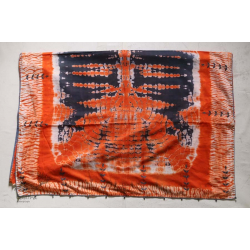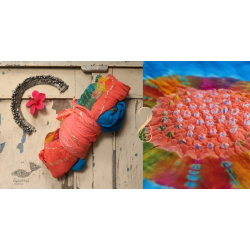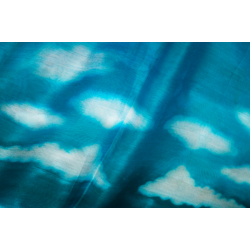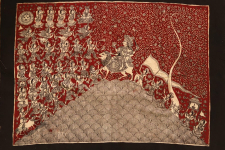The tie & dye art of treating textiles is fairly universal, with many ingenious versions scripting new genres in various parts of the world. The technique of resist dying by binding the individual parts of the cloth to shield them from the dye is usually known in India as ‘Bandhani’. There is ample evidence to suggest that the relatively complex process of mordant-dyeing was known to the inhabitants of the ancient city of Mohenjo-Daro in about 2000 BC. So, it is possible that resist dyeing was also practiced. Archival facts further confirm that in 6th-7th century A.D Bandhani cloth was depicted on walls of the Ajanta caves. even today tie & dye sarees are popular among the women's in India.
Made & Mkt by: Kalava Crafts
Product Code: 4031-SLK20-05
Shibori ~ Shibori is a Japanese counterpart for Indian traditional Tie n Dye Technique practised in Rajasthan & Gujarat in India & many other Asian countries. The basic principle behind the art is creating a resist in the fabric before dyeing, by means of folding, twisting, scrunching a..
Rs.2,470
Made & Mkt by: Kalava Crafts
Product Code: 4031-SLK20-01
Shibori ~ Shibori is a Japanese counterpart for Indian traditional Tie n Dye Technique practised in Rajasthan & Gujarat in India & many other Asian countries. The basic principle behind the art is creating a resist in the fabric before dyeing, by means of folding, twisting, scrunching a..
Rs.2,470
Made & Mkt by: Gaatha
Product Code: 4064-CBS-12
Gathering commences in the middle of deserted pavilions where velvet carpets adorn the Dessert lands & Manganiyars play folk music as a bugle for the occasions to begin. Royals from every corner are called upon to decorate the occasion. It’s a sight to behold, men & women welcoming the Kings..
Rs.1,450
Made & Mkt by: Gaatha
Product Code: 4064-CBS-01
Gathering commences in the middle of deserted pavilions where velvet carpets adorn the Dessert lands & Manganiyars play folk music as a bugle for the occasions to begin. Royals from every corner are called upon to decorate the occasion. It’s a sight to behold, men & women welcoming the Kings..
Rs.1,450
Made & Mkt by: Knots & Dots by Khatri Talha
Product Code: 2035-KDS-16
A familiar chatter swells in the air as feet chase the trail of a carelessly flying odhani in the by-lanes of Bhuj, spilling colors all over. While the women are busy tying knots in fabric, their whispered secrets quietly sneak into these tied bundles. They remain unnoticed but intact till the ..
Rs.12,500
Made & Mkt by: Knots & Dots by Khatri Talha
Product Code: 2035-KDS-14
A familiar chatter swells in the air as feet chase the trail of a carelessly flying odhani in the by-lanes of Bhuj, spilling colors all over. While the women are busy tying knots in fabric, their whispered secrets quietly sneak into these tied bundles. They remain unnoticed but intact till the ..
Rs.12,500
Made & Mkt by: Zuber Khatri
Product Code: 4023-Z-03
A familiar chatter swells in the air as feet chase the trail of a carelessly flying odhani in the by-lanes of Bhuj, spilling colors all over. While the women are busy tying knots in fabric, their whispered secrets quietly sneak into these tied bundles. They remain unnoticed but intact till the ..
Rs.10,500
Made & Mkt by: Studio Malang
Product Code: 2405-MLN-10
Shibori ~ Shibori is a Japanese counterpart for Indian traditional Tie n Dye Technique practised in Rajasthan & Gujarat in India & many other Asian countries. The basic principle behind the art is creating a resist in the fabric before dyeing, by means of folding, twisting, scrunching a..
Rs.6,000
Made & Mkt by: Studio Malang
Product Code: 2405-MLN-09
Shibori ~ Shibori is a Japanese counterpart for Indian traditional Tie n Dye Technique practised in Rajasthan & Gujarat in India & many other Asian countries. The basic principle behind the art is creating a resist in the fabric before dyeing, by means of folding, twisting, scrunching a..
Rs.6,000
































-225x150w.jpg)
-225x150w.jpg)
-225x150w.jpg)
-225x150w.jpg)
-225x150w.jpg)
-225x150w.jpg)
-225x150w.jpg)
-225x150w.jpg)
-225x150w.jpg)
-225x150w.jpg)
-225x150w.jpg)
-225x150w.jpg)









-225x150w.jpg)

-225x150w.jpg)

-225x150w.jpg)
-225x150w.jpg)
-225x150w.jpg)




-225x150w.jpg)
-225x150w.jpg)

-225x150w.jpg)
-225x150w.jpg)
-1-225x150w.jpg)







